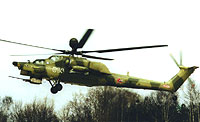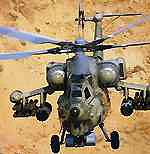Russian strike helicopter Mi-28N readies for production
24 Jan 2007
Mikhailov is chairman of a commission that has been appointed to look into the progress being made by the helicopter as it heads for manufacture.
 According to Mikhailov, the Mi-28N has shown very high levels of reliability. He pointed out that so far, the Mi-28N had undergone more than 300 test flights, of which only 17 could be dubbed as failures. Mikhailov said that he was not aware of any other "flying vehicle that exhibited such a high level of capabilities."
According to Mikhailov, the Mi-28N has shown very high levels of reliability. He pointed out that so far, the Mi-28N had undergone more than 300 test flights, of which only 17 could be dubbed as failures. Mikhailov said that he was not aware of any other "flying vehicle that exhibited such a high level of capabilities."
According to Mikhailov, continuous efforts were being made to market the helicopter and that these efforts would be given further impetus with every passing year.
He also revealed that the N55 helicopter regiment, based at Korenovsk, in the Krasnodar territory, would be the recipient of the first batch of these helicopters.
Rosvertol
Rosvertol, of Rostov-on-Don, is Russia's leading manufacturer of combat helicopters and heavy civilian transport helicopters. The production plant has been producing helicopters designed by the Mil design bureau since 1956 and is a recognised world leader in the manufacture of heavy-lift helicopters. It builds the Mi-26 Halo, the largest heavy-lift helicopter in the world.
Rosvertol has also built the Mi-6 Hook and Mi-10 Harke heavy-lift helicopters, as well as the Mi-25 and Mi-35 Hind combat attack helicopters. It is now all set to roll out the Mi-28 Havoc.
Design
The Mi-28N (Russian name - Night Hunter) is designed to attack tanks and other armoured formations, as well as low-speed aerial targets and enemy personnel. It is armed with a mixture of air-to-air and air-to-ground missiles, unguided rockets, and cannons. The Russian Air Force, reportedly, has plans to procure up to 50 of the N or Night Hunter variant.
Armour
 The Night Hunter has a fully armoured cabin, which can withstand the impact of 7.62 mm and 12.7 mm bullets, as well as 20 mm shell fragments. The Night Hunter has an integrated electronic combat system, the main components of which include a microwave radar antenna, mounted above the rotor head, and a forward-looking infrared (FLIR) system. The pilot uses a helmet-mounted target designator, which follows the direction of the pilot's eyes and allocates targets to the navigator's surveillance and fire control system.
The Night Hunter has a fully armoured cabin, which can withstand the impact of 7.62 mm and 12.7 mm bullets, as well as 20 mm shell fragments. The Night Hunter has an integrated electronic combat system, the main components of which include a microwave radar antenna, mounted above the rotor head, and a forward-looking infrared (FLIR) system. The pilot uses a helmet-mounted target designator, which follows the direction of the pilot's eyes and allocates targets to the navigator's surveillance and fire control system. Engines
The Mi-28 helicopter is powered by two TV3-117 VMA turbo-shaft engines, fitted on either side of the fuselage, as well as an auxiliary power unit. As compared to its predecessor, the Mi-24, the thermal signature of the helicopter stands reduced by a factor of 2.5.






























